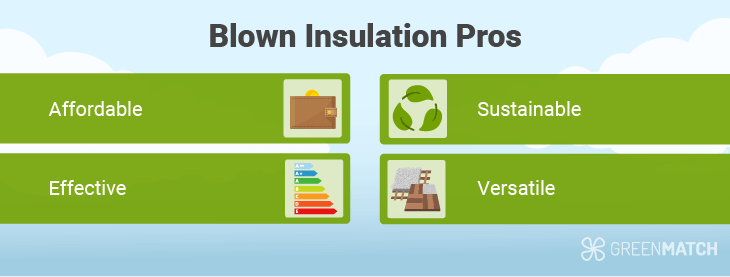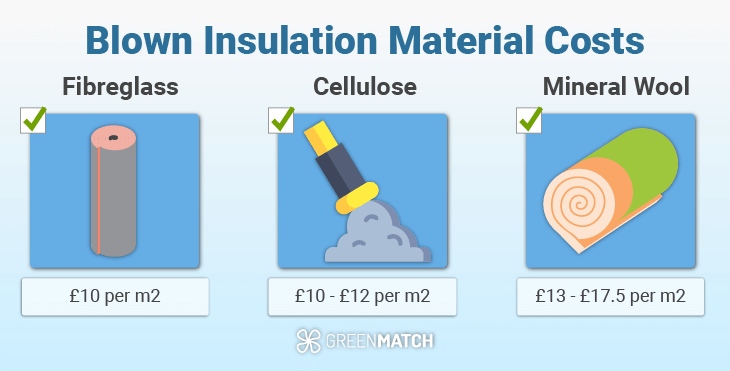Answer these simple questions and we will find you the BEST prices
Which type of solar quotes do you need?
It only takes 30 seconds
100% free with no obligation

Get Free quotes from insulation specialists near you

Save money by comparing quotes and choosing the most competitive offer

The service is 100% free and with no obligation
- GreenMatch
- Insulation
- Blown In Insulation
Your Ultimate Guide to Blown Insulation UK


- Blown-in insulation is a special method of applying insulation material (such as cellulose) by blowing it into spaces like walls and lofts using specialised equipment.
- Loose-fill insulation materials such as cellulose, mineral wool, and fibreglass work well as blown insulation.
- Blown in loft and wall insulation can reduce home heat loss by a combined 59%.
As homes in the UK grapple with rising energy costs, homeowners are seeking effective and affordable methods to upgrade their domestic thermal efficiency. As such, home insulation has become a big focus. Blown insulation is a popular option due to its versatility, effectiveness and relative budget-friendliness.
Using loose-fill materials such as cellulose insulation, mineral fibres, or fibreglass, blown in insulation is best suited for lofts, cavity walls and stud walls, slashing your heat loss by more than half and bringing you staggering energy bill savings. But what exactly is blown in insulation, and is it suited to your needs?
This GreenMatch UK guide will guide you through blown in insulation, material types, pros and cons to give you the best idea of what to expect.
Ready to insulate your home? Look no further than GreenMatch UK for all your needs. With our services, you can receive up to 3 free home-tailored quotes from pre-vetted installers in your area. All you need to do is fill out our simple 30-second online form and leave the rest to us. No charges or obligations apply. Click the button below to begin!
- Describe your needs
- Get free quotes
- Choose the best offer
It only takes 30 seconds



What is blown insulation?

Blown in insulation is when loose-fill insulation material is blown into spaces such as cavity walls or lofts using specialised industry equipment. It’s commonly used for various insulation upgrades, such as blown cavity wall insulation, interior stud walls, and lofts.
Usually, blown in insulation uses loose-fill fibrous materials such as mineral wool, fibreglass, or cellulose. These materials tend to be more sustainable, recyclable and affordable than most other insulation materials on the market.
The material is installed differently depending on the area of your house you are installing, but in general, this is what you could expect:
- Preparation: An installer will first make sure the area of insulation is clear of debris, well-sealed, and moisture-free. If any gaps, cracks, or openings exist, these will be sealed to help prolong the life span of the insulation.
- Installation: Then, an installer will use an industry-specialised hose to blow insulation material into the space. If this is for cavity walls, the installer will drill small holes in the outer wall to access the cavity space.
- Wrapping up: Once the blown insulation is secure, the space will be sealed off nicely to avoid moisture and weathering. For cavity walls, this will include cementing over the previously drilled holes for a seamless finish.
The whole process of blown-in insulation takes no more than a few hours and is entirely handled by professional installers. It’s recommended to work with an accredited blown-in insulation installer to make sure the job is done with good craftsmanship and can bring your home decades of comfort.
Benefits of blown insulation

Blown insulation is a wonderfully effective home upgrade for thermal performance that comes with plenty of positives worth considering. Here are just some of the key benefits you can expect:
- Affordable: Loose-fill insulation materials are generally far more affordable than some other synthetics. Materials like fibreglass and cellulose cost as little as £10 per m2, with mineral wool costing around £13 - £17.5.
- Effective: Blown-in insulation is a very effective way of saving energy, reflected in annual your energy bills. Blown-in cavity wall insulation alone can save a detached house up to £370 every year.
- Sustainable: Loose-fill insulation materials are often made sustainably, and from recycled materials. For example, cellulose is almost entirely made from recycled paper and wood products, whilst mineral wool and fibreglass are entirely reusable.
- Versatile: Blown-in insulation is a versatile approach, especially for harder-to-access areas of your home. For example, if your loft is not suited for living and is hard to access, it’s a perfect area to fill with blown-in insulation.
With all things considered, blown insulation emerges as a great home insulation upgrade fit for most budgets and home types.
What are the problems of blown in insulation in the UK?

While beneficial, blown insulation comes with its downsides like any other insulation approach. Most of these downsides are avoidable with a professional but can become a problem with faulty jobs and inexperienced installers.
- Damp and condensation: Some loose-fill materials such as cellulose are especially prone to moisture and dampness due to their material composition. This can lead to mould and mildew, as well as reduced effectiveness. Proper airtight sealing and healthy amounts of ventilation are needed to avoid this.
- Loss of efficiency: Loose-fill insulation is light and made up of many small pieces. That way, moisture exposure can very quickly reduce its thermal efficiency, leading to poor insulation and the need to dry out or remove the material entirely.
- Clumping: Loose-fill insulation material can condense and clump up over time. This can create gaps and cold spots in your insulation, leading to reduced efficiency. A standard top-up of loose-fill insulation can help solve this problem.
- Pest issues: Loose-fill insulation that is not properly sealed can become a nesting ground for insects and pests. These can form hollows in your insulation material, leading to cold spots. Not to mention, pests are unsightly.
While a DIY installation may be tempting, a proper installation will ensure that you do not have to face these problems. That way, you can save hundreds on burdensome repairs and enjoy decades of thermal comfort in your home.
Blown in insulation materials
Blown in insulation is usually carried out with a few key materials; cellulose, mineral wool, or fibreglass. All three are relatively similar but come with slight differences worth considering.
Here’s a breakdown of what to expect per blown fibre insulation:
| Material | Best for | R-value |
|---|---|---|
| Fibreglass | Loft, internal stud walls. | 2.2 - 4.3 |
| Cellulose | Loft, cavity walls, internal stud walls. | 2.4 - 2.8 |
| Mineral wool | Loft, cavity walls, internal stud walls. | 2.5 - 3.3 |
With that covered, let’s take a deeper look at each blown in insulation material and what to expect.
Blown cellulose insulation
Blown cellulose insulation is one of the most affordable and sustainable materials on the market. Made from recycled paper and wood products, cellulose comes as loose-fill insulation and can be used as blown cavity wall insulation, behind internal stud walls, and in loft spaces.
- One of the cheapest materials
- Fully sustainable and recyclable
- Being made from paper and wood, cellulose is moisture-prone.
- Can clump over time, creating gaps and cold spots.
Blown fibreglass
Blow in fibreglass insulation is made of tiny glass fibres that are blown into a space using specialised equipment. They are materially the same thing as fibreglass batts and blankets, only as tiny shredded particles. This material is often used as blown in attic insulation, particularly in lofts that are not used as living spaces.
- Effective heat retention
- Flame-resistant
- Highly irritating if inhaled or in contact with skin.
- Open spaces with blown fibreglass cannot be used for living purposes.
Mineral wool
One of the most popular insulation materials on the market, mineral wool can also be found as loose-fill and installed as blow in insulation. Made either from rock or glass, blown in mineral wool is effective in heat retention, relatively affordable, and sustainable. It makes great insulation for loft spaces.
- Naturally moisture resistant
- Flame and fire-resistant
- Has some acoustic insulation properties
- Highly irritating if inhaled or in contact with skin.
Best blown-in insulation
The best insulation material will depend on several factors, such as your budget, insulation needs, existing insulation, and personal preferences.
When looking at thermal performance balanced with affordability, fibreglass emerges as one of the best blown in insulation materials on the market. Not only is it relatively cheap and effective, but it’s also quite sustainable and can even be recycled.
Additionally, fibreglass is non-flammable, electrically-non conductive, and does not release harmful chemicals. This makes it a safer bet for long-term insulation.
How much does blown in insulation cost in the UK?

Blown insulation is considered to be on the more budget-friendly spectrum when it comes to insulation methods. Your blown insulation cost can differ depending on your circumstances, but loose-fill insulation materials are generally more affordable than synthetic alternatives.
Nevertheless, the cost of insulation differs based on your circumstances. Here’s a blown in insulation cost breakdown for each material per m2:
| Material | Cost per m2 |
| Fibreglass | £10 |
| Cellulose | £10 - £12 |
| Mineral wool | £13 - £17.5 |
Choosing to insulate your home is a great first step, but making sure the job is done correctly is just as important. A professional installer is a fine line between decades of home comfort and shabby insulation that keeps needing repairs.
With the sea of installers out there, finding a bargain is no small feat. The best way to do so is to ask a large sample of installers for quote prices and narrow down your most affordable options. Luckily, GreenMatch UK can save you endless hours by handling this for you.
By filling out our simple 30-second form, you can receive up to 3 free home-tailored quotes directly from our nationwide network of pre-vetted professionals. The best part? Our services are completely free of charge and with no obligations. Click the button below to begin!
- Describe your needs
- Get free quotes
- Choose the best offer
It only takes 30 seconds



FAQ
Blown loft insulation prices depend on several factors, such as the size and condition of your loft, existing insulation, your chosen material, and personal preferences. Generally speaking, cold loft insulation for a standard semi-detached home costs around £950.
Blown-in insulation is completely worth the investment if done correctly by a professional installer. It can bring your home decades of thermal comfort for a much smaller cost than other popular synthetic insulation materials.
Blown-in insulation needs to be installed professionally to avoid problems such as moisture buildup, clumping, and pest infestation. Luckily, the majority of such problems can be curbed by working with an accredited installer.
Blown insulation by itself does not cause damp issues, however, a poor installation job can exasperate such problems if your home already suffers from it.
The best insulation choice for you will depend on factors such as your home type, conditions, and needs. Insulation batts are useful and less messy when it comes to loft, floor, and wall insulation, but may cost a bit more than blown insulation. Alternatively, rolled insulation is much easier to install DIY whereas blown insulation requires a professional.

Akif is a copywriter at GreenMatch since 2023. With a keen interest in community sustainability, green solutions and the role of digital media in identifying climate trends, he aims to hone in on his background in International Studies and Digital Media to provide a multidisciplinary approach to written content rooted in credible research and accuracy.
We strive to connect our customers with the right product and supplier. Would you like to be part of GreenMatch?

